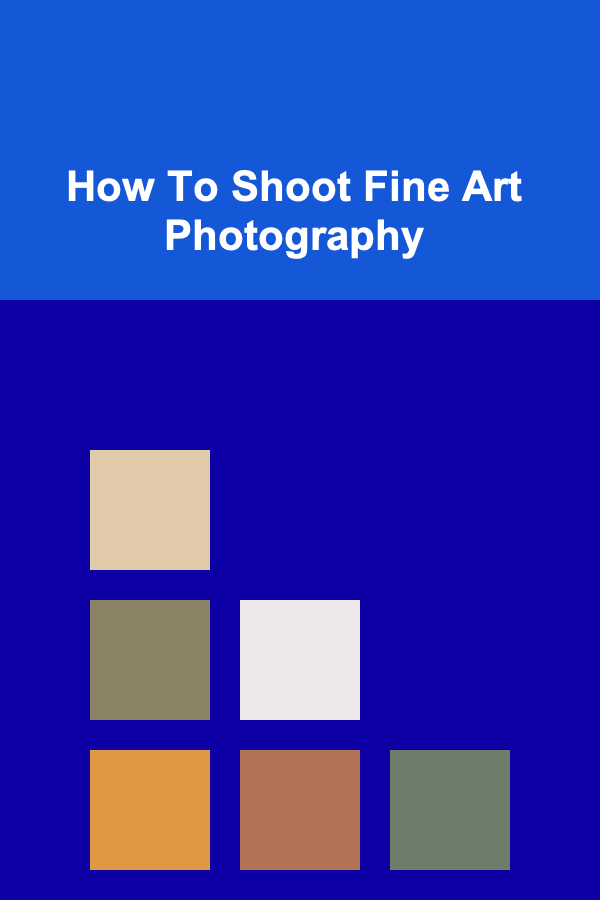
How To Shoot Fine Art Photography
ebook include PDF & Audio bundle (Micro Guide)
$12.99$5.99
Limited Time Offer! Order within the next:

Fine art photography is one of the most expressive and creative forms of visual art. Unlike commercial photography, which is often focused on capturing subjects for advertising, fine art photography is about creating photographs that are intended to be appreciated as art. These images are meant to evoke emotions, stimulate thought, and engage viewers in a deeper conversation with the subject matter. Creating fine art photography involves not only technical skills but also a strong vision, creativity, and an understanding of art principles. This article will guide you through the process of shooting fine art photography, from conceptualization to post-processing.
Understanding Fine Art Photography
What Is Fine Art Photography?
Fine art photography is a genre of photography where the photographer creates images that are meant to be seen as artistic expressions. This form of photography can encompass a wide range of styles, including portraiture, landscape, still life, abstract, and more. What distinguishes fine art photography from other forms of photography is the photographer's intention to create something that is not just visually pleasing but also conceptually powerful and thought-provoking.
Fine art photographers approach their work with an artistic mindset, aiming to produce images that are evocative, emotional, and contemplative. This process is often driven by a personal vision or message that the photographer wishes to convey.
The Role of Vision and Conceptualization
Fine art photography is not about merely taking a beautiful picture; it's about creating a piece of art that communicates something. This is where the role of vision and conceptualization comes into play. Every fine art photograph begins with an idea, a concept, or an emotional response to a subject or scene.
Before you press the shutter, it's important to ask yourself:
- What is the message I want to convey?
- How can I evoke an emotional response from the viewer?
- What story am I telling through this photograph?
Your vision will guide every decision you make while shooting: the lighting, composition, color palette, and even the choice of subject matter. Fine art photography is a deeply personal process, and your ideas and emotions should be at the forefront of your work.
The Technical Aspects of Fine Art Photography
While the creative side of fine art photography is crucial, technical skills are equally important. Mastery of your camera and understanding how to manipulate exposure, focus, and composition will allow you to bring your artistic vision to life.
1. Choosing the Right Gear
Fine art photography can be shot with a variety of camera systems, including DSLR, mirrorless, medium format, or even film cameras. The key is to choose equipment that suits your style, subject matter, and artistic goals.
Camera
The camera you use will depend on your preferences and the specific project you are working on. While digital cameras offer more flexibility in terms of exposure and post-processing, some fine art photographers prefer film cameras for their unique aesthetic qualities. Medium format cameras, such as the Hasselblad or Mamiya, are popular choices among fine art photographers due to their large sensors and incredible detail.
- DSLR and Mirrorless Cameras: These are excellent for fine art photographers due to their versatility, ease of use, and range of lenses.
- Film Cameras: Many fine art photographers prefer the texture and tonality that film provides. Film can offer more unpredictability and can help create a timeless aesthetic.
- Medium Format Cameras: These cameras provide exceptional resolution and detail, making them ideal for large prints.
Lenses
Your choice of lens will play a significant role in the visual impact of your image. Lenses with wide apertures (e.g., f/1.4, f/2.8) are often favored in fine art photography because they create a shallow depth of field, isolating subjects from the background and creating a dreamy, ethereal look. A prime lens (e.g., 50mm, 85mm) is often preferred for its sharpness and ability to create stunning bokeh.
Wide-angle lenses (e.g., 24mm, 35mm) are great for landscape photography, as they allow you to capture expansive scenes with dramatic perspectives. On the other hand, telephoto lenses (e.g., 70-200mm) can be used to compress the space in a scene and highlight specific details or subjects.
2. Mastering Exposure
Exposure in photography refers to the amount of light that hits the camera's sensor, and it has a direct impact on the final image. Fine art photographers often aim for specific exposure settings to create the mood or atmosphere they envision.
There are three key elements of exposure:
- Aperture: The aperture controls the depth of field in your images. A wide aperture (low f-stop number) results in a shallow depth of field, which is useful for isolating a subject against a blurred background.
- Shutter Speed: Shutter speed determines how long the camera's shutter remains open. A slow shutter speed can create motion blur, which might be desirable for certain artistic effects, while a fast shutter speed can freeze motion.
- ISO: ISO determines the sensitivity of the camera's sensor to light. A low ISO (e.g., 100 or 200) is ideal for bright conditions and ensures minimal noise. In contrast, a higher ISO (e.g., 1600 or above) is used in low-light situations but can introduce more noise in the image.
Balancing these three elements will allow you to achieve the desired exposure for your fine art photograph. Many photographers shoot in manual mode to have full control over these settings.
3. Composition
Composition is one of the most important aspects of fine art photography. It's not just about where you place your subject in the frame---it's about how you arrange all the elements in your image to create a balanced, harmonious, and compelling visual experience.
Some key compositional techniques include:
- The Rule of Thirds: This classic compositional technique divides the image into nine equal parts by two horizontal and two vertical lines. Placing your subject along these lines or at their intersections creates a dynamic and balanced composition.
- Leading Lines: Lines in the image (e.g., roads, rivers, fences) can be used to guide the viewer's eye toward the subject, creating a sense of depth and movement.
- Framing: Use elements in your environment (e.g., doorways, windows, branches) to frame your subject and draw attention to it.
- Negative Space: The empty or open space around your subject can enhance its impact, giving it room to breathe and allowing the viewer's eye to focus on the main subject without distraction.
- Symmetry and Patterns: Symmetry and repeating patterns can create a sense of order and balance, contributing to the aesthetic appeal of the image.
The goal is to create a composition that supports the message you want to convey through your photograph. Be intentional with each decision, whether it's the placement of your subject or the way you use light and shadows.
4. Lighting
Lighting is one of the most powerful tools in photography. It can dramatically affect the mood, texture, and depth of your images. Fine art photographers often use lighting to enhance the emotion or atmosphere they want to evoke.
- Natural Light: Many fine art photographers prefer natural light because of its subtlety and warmth. Early morning or late afternoon light (the "golden hour") creates a soft, diffused glow that can be ideal for portraits or landscapes.
- Artificial Light: Studio lighting or controlled artificial lighting can be used to create dramatic effects, such as high contrast or stark shadows. Softboxes, reflectors, and diffusers can help you manipulate the quality of light to suit your vision.
- Backlighting: Positioning your light source behind the subject can create a sense of mystery or otherworldliness, with the subject being illuminated from behind while remaining in shadow.
- Light and Shadow: Fine art photography often plays with the interplay of light and shadow to create mood and depth. Strong contrasts between light and dark can evoke feelings of tension, drama, or melancholy.
Post-Processing in Fine Art Photography
Post-processing is where you can truly refine your image and bring your artistic vision to life. Fine art photographers often spend considerable time in editing, enhancing the image's color, tone, and texture to create the exact mood they desire.
1. Color Grading and Tone
The color palette in a photograph can have a profound impact on its emotional resonance. Fine art photographers often adjust the color balance to emphasize particular tones or evoke certain feelings.
- Monochrome: Black and white photography is a classic choice in fine art photography. It strips the image of color, allowing the viewer to focus on shape, texture, and form. Fine art photographers often use black and white to create timeless, dramatic, or minimalist imagery.
- Warm vs. Cool Tones: Adjusting the warmth or coolness of the image can set the tone. Warm tones (e.g., oranges, yellows) can create a sense of intimacy or nostalgia, while cool tones (e.g., blues, greens) evoke a sense of calmness or detachment.
- Selective Color Adjustments: Fine art photographers often selectively adjust colors to emphasize certain elements within the frame. For example, you might enhance the reds and oranges of a sunset while desaturating the surrounding elements to draw attention to the sky.
2. Retouching and Refining Details
While fine art photography is about creativity, it's also about perfection. Retouching allows you to fine-tune the details in your image, whether it's removing distracting elements or enhancing textures.
- Dodging and Burning: This technique involves lightening (dodging) or darkening (burning) specific areas of an image to add contrast, depth, and focus.
- Sharpening: Increasing the sharpness of your image can highlight fine details and textures, which is especially important in fine art photography where every detail matters.
- Noise Reduction: In some cases, especially when shooting at high ISOs, noise can be present in the image. Reducing noise can make the final image look cleaner and more polished.
3. Cropping and Resizing
Fine art photographers often crop their images to enhance the composition and remove any distracting elements. Sometimes, resizing is necessary for specific print sizes or to fit the image into a particular frame or gallery space.
Conclusion
Shooting fine art photography is an intricate process that blends creativity, technical skill, and an understanding of artistic principles. It requires the photographer to have a clear vision, a deep understanding of their tools, and the patience to refine their work during post-processing. Fine art photography is about creating images that speak to the viewer on an emotional level, that evoke feelings, ideas, and questions.
By focusing on conceptualization, mastering your technical skills, experimenting with light and composition, and fine-tuning your images in post-processing, you can develop a personal style and begin creating fine art photographs that tell your unique story. Whether you're capturing a still life, a portrait, or a landscape, fine art photography gives you the power to transform the ordinary into the extraordinary.

Earn Money by Creating Deep Learning Models for Businesses
Read More
How to Market Your Home Music Lessons to Local Students
Read More
How to Style Your Holiday Table with Elegant and Simple Ideas
Read More
Saving Money on Baby Diapers and Wipes: Best Brands and Bulk Buying Tips
Read More
Choosing the Right Foam Cannon for Efficient Car Washing
Read More
How to Create a Printable Grocery Shopping To-Do List Template
Read MoreOther Products

Earn Money by Creating Deep Learning Models for Businesses
Read More
How to Market Your Home Music Lessons to Local Students
Read More
How to Style Your Holiday Table with Elegant and Simple Ideas
Read More
Saving Money on Baby Diapers and Wipes: Best Brands and Bulk Buying Tips
Read More
Choosing the Right Foam Cannon for Efficient Car Washing
Read More